Gennaro Cuofano's Blog, page 161
April 19, 2021
What Is Proof-of-Activity And Why It Matters To Understand Blockchain Business Models
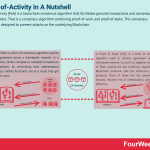
Proof-of-Activity (PoA) is a blockchain consensus algorithm that facilitates genuine transactions and consensus amongst miners. That is a consensus algorithm combining proof-of-work and proof-of-stake. This consensus algorithm is designed to prevent attacks on the underlying Blockchain.
Understanding Proof-of-ActivityProof-of-Activity is a combination of Proof-of-Work (PoW) and Proof-of-Stake (PoS).
Proof-of-Work is the most common consensus algorithm and is utilized by Bitcoin among other cryptocurrencies. While PoW maintains blockchain integrity and security, it does consume vast amounts of computing power and electricity. There are also issues with scalability and centralization, with most of the hashing power held by a select few individuals or groups.
Proof-of-Stake remedies the resource intensiveness of PoW but also suffers from a form of centralization. In this case, centralization is caused by early adopters who earn a larger share of block creation fees and discourage late adopters from participating.
Proof-of-Activity was first proposed in a research paper in 2014. In the abstract of the paper, the authors “propose a new protocol for a cryptocurrency, that builds upon the Bitcoin protocol by combining its Proof-of-Work component with a Proof-of-Stake type of system. Our Proof-of-Activity (PoA) protocol offers good security against possibly practical attacks on Bitcoin, and has a relatively low penalty in terms of network communication and storage space.“
How blocks are generated in a PoA networkThe following steps dictate the block creation process in a PoA network:
To start, each miner uses hash power to try and generate an empty block header. This is header data consisting of the hash of the previous block, the miner’s address, the height relative to the genesis block, and a nonce. It’s important to note that the header does not include past transactions.A miner succeeds in generating a block header when the hash of their block header data is less than the current difficulty target. Once successful, the block header is broadcasted to the network.The hash of the block header is linked with the hash of the previous block. Each combination is then hashed and follow-the-satoshi is invoked with each hash acting as input. Follow-the-satoshi is a PoA subroutine, which transforms a pseudorandom value into a small unit of cryptocurrency called a satoshi. Each satoshi is picked randomly from the satoshis that have been already mined.Active miners then check whether the block header from step two is valid. Does it contain the hash of the previous block and does it meet the current difficulty? After validation, each miner determines whether they are one of the stakeholders of the block. Successful miners sign the hash block header with a private key that determines their satoshi and broadcasts their signature to the network. This process is repeated until every chosen validator signs the block.The last miner to sign the block then broadcasts the wrapped block to the network. The block is considered a legitimate extension of the blockchain once other nodes see validity in the above four steps. Similar to the Bitcoin blockchain, the nodes try to extend the longest branch they are aware of by assessing PoW difficulty. The fees collected by the last miner are shared between themselves and the remainder of the “winners”.Protection against malicious attacksBoth PoS and PoW were designed to prevent 51% attacks, where one individual or party attempts to gain majority control over mining power.
However, PoA adds another layer of protection against such attacks. In theory, a malicious actor would need to have 51% or more of the total mining power in addition to 51% or more of the coins staked in the network.
Key takeaways:Proof-of-Activity (PoA) is a hybrid of the PoS and PoW consensus mechanisms. It facilitates genuine transactions and consensus among miners.PoA attempts to address centralization issues in both PoS and PoW. It also seeks to do so in a manner that is not resource-intensive.The probability of a 51% attack on a PoA system is reduced significantly. This is because a malicious actor would need majority control of both the mining hash rate and the number of coins in a system.Read Next: Proof-of-stake, Proof-of-work, Bitcoin, Ethereum, Blockchain.
Main Free Guides:
Business ModelsBusiness StrategyBusiness DevelopmentDigital Business ModelsDistribution ChannelsMarketing StrategyPlatform Business ModelsRevenue ModelsTech Business ModelsBlockchain Business Models FrameworkThe post What Is Proof-of-Activity And Why It Matters To Understand Blockchain Business Models appeared first on FourWeekMBA.
What Is The Nothing-at-stake Problem And Why It Matters To Understand Blockchain Business Models
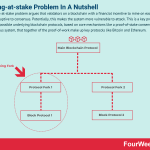
The nothing-at-stake problem argues that validators on a blockchain with a financial incentive to mine on each fork are disruptive to consensus. Potentially, this makes the system more vulnerable to attack. This is a key problem that makes possible underlying blockchain protocols, based on core mechanisms like a proof-of-stake consensus, a key consensus system, that together of the proof-of-work make up key protocols like Bitcoin and Ethereum.
Understanding the nothing-at-stake problemThe nothing-at-stake problem describes a theoretical security issue in proof-of-stake consensus systems.
 A Proof of Stake (PoS) is a form of consensus algorithm used to achieve agreement across a distributed network. As such it is, together with Proof of Work, among the key consensus algorithms for Blockchain protocols (like the Ethereum’s Casper protocol). Proof of Stake has the advantage of the security, reduced risk of centralization, and energy efficiency.
A Proof of Stake (PoS) is a form of consensus algorithm used to achieve agreement across a distributed network. As such it is, together with Proof of Work, among the key consensus algorithms for Blockchain protocols (like the Ethereum’s Casper protocol). Proof of Stake has the advantage of the security, reduced risk of centralization, and energy efficiency.This issue can be explained by noting that block creators on these systems do not have anything at stake when the network forks. When a network such as Bitcoin forks, active miners are incentivized to use the Consensus Method to choose one chain.
Since a mining unit cannot create blocks on both chains simultaneously, the fork is theoretically forced to resolve itself because of a scarcity of hash power. However, the reality of a Proof-of-Stake (PoS) protocol is rather different.
Instead of hash power, token stake is the scarce block production resource. Participants deposit tokens into a pool from which a “winner” is selected to propose the next block.
However, forks sometimes occur because of malicious transaction reversal attempts. In some instances, two winners from the original pool are selected.
In an ideal world, participants would choose only one of the two chains. But many miners choose both forks because the original deposit is valid on both chains. That is, it costs the miner nothing more to validate on both chains and collect the subsequent transaction fees and rewards.
The nothing-at-stake problem and opportunity costOpportunity cost can be used to explain the behavior of a miner and how it contributes to the nothing-at-stake problem.
In general terms, the miner can follow both chains indefinitely without any cost. In fact, this is the optimal strategy. If the miner chooses one chain, he or she risks losing the transaction fees from the orphaned chain.
If the miner chooses both, he or she has to do nothing more than wait for one chain to become the winner. The rewards, of course, are collected either way.
The opportunity cost here is much different from the costs associated with quitting a job, for example. A person that decides to quit their job may miss out on an impending pay rise or bonus. Proof-of-stake effectively allows that person to have two full-time jobs at no expense. If they don’t get promoted in the first job, they will in the second. There is nothing to lose, which gives the nothing-at-stake problem its name.
Ramifications of the nothing-at-stake problemThe nothing-at-stake problem is similar to the tragedy of the commons, an economic theory arguing that individuals who act in their self-interest neglect the well-being of society.
When a miner chooses both chains to maximize their returns, the integrity of each chain and the network as a whole is compromised. A malicious actor can intentionally fork the chain and double-spend tokens in a very subtle and covert way.
First, the actor continues to validate on both chains like everyone else. Then, they wait for confirmation of a bad transaction and stop validating on the first chain. The balance of voting power then shifts and the second chain begins to outpace the original. Eventually, the chain with the bad transaction becomes accepted officially while the first is orphaned.
Key takeaways:The nothing-at-stake problem describes a scenario where block creators on generic proof-of-stake protocols have nothing to lose when the network forks.The nothing-at-stake-problem can be explained by opportunity cost. Miners can follow both chains and reap the rewards at no additional cost to their original deposit.The nothing-at-stake-problem has some similarities to modern economic theory. When each miner acts in their own self-interests, they neglect the integrity and security of the network as a whole.Read Next: Proof-of-stake, Proof-of-work, Bitcoin, Ethereum, Blockchain.
Main Free Guides:
Business ModelsBusiness StrategyBusiness DevelopmentDigital Business ModelsDistribution ChannelsMarketing StrategyPlatform Business ModelsRevenue ModelsTech Business ModelsBlockchain Business Models FrameworkThe post What Is The Nothing-at-stake Problem And Why It Matters To Understand Blockchain Business Models appeared first on FourWeekMBA.
April 11, 2021
VBDE Framework: Dissecting Blockchain Business Models
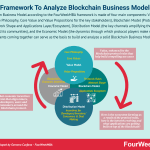
A Blockchain Business Model according to the FourWeekMBA framework is made of four main components: Value Model (Core Philosophy, Core Values and Value Propositions for the key stakeholders), Blockchain Model (Protocol Rules, Network Shape and Applications Layer/Ecosystem), Distribution Model (the key channels amplifying the protocol and its communities), and the Economic Model (the dynamics/incentives through which protocol players make money). Those elements coming together can serve as the basis to build and analyze a solid Blockchain Business Model.
VBDE Blockchain Business Model Template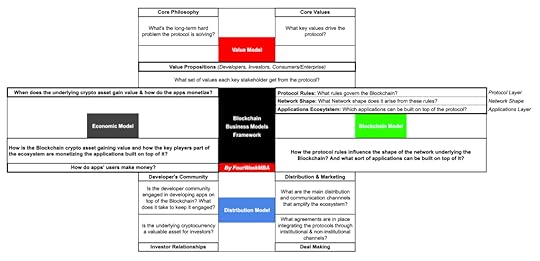
Keep reading, if you want to understand how to use the framework.
Value modelIn the value model we want to answer a few core questions:
Core Philosophy: What’s the long-term hard problem the protocol is solving?
Core Values: What key values drive the protocol?
Value Propositions: What set of values each key stakeholder get from the protocol?
When analyzing Blockchain business models is critical to understand that these look more like ecosystems with a very complex logic than just companies, with simpler dynamics. However, those complex systems are really born out of simple local rules built into the Blockchain protocol.
Blockchain ModelIn the Blockchain Model we want to understand how the protocol connects the value model to everything else. So how the rules of the Blockchain makes it compelling for the entire ecosystem to form.
In this case we need to take into account three key layers.
Protocols RulesWhat rules govern the Blockchain?
Here the sort of rules underlying the Blockchain will be critical to it. Perhaps, on Blockchain protocols like Bitcoin, rules like proof of work (PoW) are extremely important:
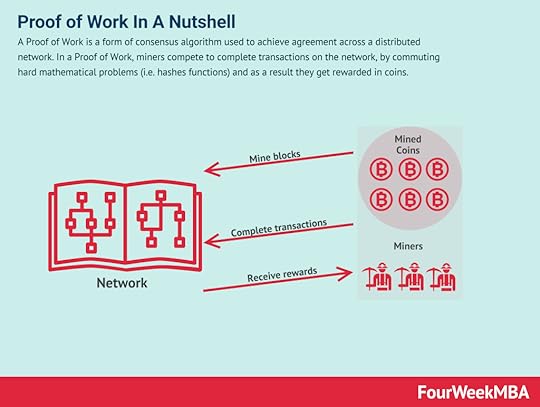 A Proof of Work is a form of consensus algorithm used to achieve agreement across a distributed network. In a Proof of Work, miners compete to complete transactions on the network, by commuting hard mathematical problems (i.e. hashes functions) and as a result they get rewarded in coins. Network Shape
A Proof of Work is a form of consensus algorithm used to achieve agreement across a distributed network. In a Proof of Work, miners compete to complete transactions on the network, by commuting hard mathematical problems (i.e. hashes functions) and as a result they get rewarded in coins. Network ShapeWhat network shape do the protocol rules determine?
Based on the protocol’s underlying core rules, a network will form, and this can take various shapes and forms (from entirely decentralized to distributed or perhaps centralized). Thus, understanding how the protocol rules are making the network evolve is critical to understanding how the balance of power moves along the Blockchain ecosystem.
Applications Ecosystem/LayerWhich applications can be built on top of the protocol?
For a Blockchain to become a business platform, it might be critical for it to be modular, or at least it gives developers the ability to build applications on top of the Blockchain, thus making it possible to expand the use cases available and developers to monetize their presence on the Blockchain.
Distribution ModelHere we want to understand how the various pieces come together to make the underlying Blockchain ecosystem sustainable and keep growing it.
Developer’s CommunityIs the developer community engaged in developing apps on top of the Blockchain? What does it take to keep it engaged?
Developers play a critical role to the development of the Blockchain’s applications and therefore it’s important to understand how the developers’ community is evolving around the protocol and what sort of applications get sprouted.
Investor RelationsIs the underlying cryptocurrency a valuable asset for investors?
What makes Blockchain protocols work in the first place are the strong economic incentives underlying them. Thus, we might want to argue there might be no Blockchain without Crypto and vice versa. Therefore, as the Blockchain ecosystem evolves, monitoring how investors are responding to it is also important. Keep in mind that a Blockchain is much much more than a simple entity; that is a “super-entity.” As such, it needs the support of multiple stakeholders to thrive.
Mining IncentivesWhat incentives exist for miners to keep contributing to the development and growth of the Blockchain network?
Miners also play a crucial role in the development of the Blockchain. It’s important to notice that some Blockchains like Bitcoin are primarily based on Proof of Work, making miners the key players to mine new coins. Other players/users can also become miners when it comes to other protocols like Ethereum (where there is also a Proof of Stake mechanism).
Deal MakingWhat agreements are in place integrating the protocols through institutional & non-institutional channels?
For a protocol to scale, it needs to be adopted by a wide number of individuals and institutions. Therefore, here the progress in making the protocol integrated within other institutional and non-institutional systems becomes very important.
Economic modelHow is the Blockchain crypto-asset gaining value and how the key players part of the ecosystem are monetizing the applications built on top of it?
While Blockchain protocols can be built far beyond incentives than economic ones, it’s important to notice that what keeps the ecosystem sustainable over time are the powerful economic incentives aligning various players part of the ecosystem. Thus, it’s important to understand what drives these players to come together.
Key takeawaysA Blockchain Business Model looks more like a dynamic ecosystem around which an entire set of players are
Value Model
Core Philosophy: What’s the long-term hard problem the protocol is solving?Core Values: What key values drive the protocol?Value Propositions: What set of values each key stakeholder get from the protocol?Blockchain Model
Protocols Rules: What rules govern the Blockchain?Network Shape: What network shape do the protocol rules determine?Applications Rules: Which applications can be built on top of the protocol?Distribution Model
Developer’s Community: Is the developer community engaged in developing apps on top of the Blockchain? What does it take to keep it engaged?Investor Relations: Is the underlying cryptocurrency a valuable asset for investors?Mining Incentives: What incentives exist for miners to keep contributing to the development and growth of the Blockchain network?Economic Model
How is the Blockchain crypto-asset gaining value and how the key players part of the ecosystem are monetizing the applications built on top of it?
Blockchain Business Models To Understand How Most Blockchain Protocols Work!
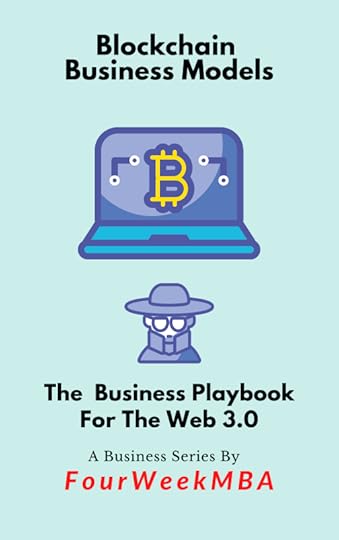
Read Next: Tech Business Models Framework
Main Free Guides:
Business ModelsBusiness StrategyBusiness DevelopmentDigital Business ModelsDistribution ChannelsMarketing StrategyPlatform Business ModelsRevenue ModelsTech Business ModelsThe post VBDE Framework: Dissecting Blockchain Business Models appeared first on FourWeekMBA.
April 3, 2021
What Is A Distributed Ledger And Why It Matters In Business?
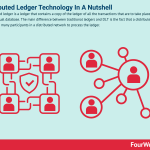
A distributed ledger is a ledger that contains a copy of the ledger of all the transactions that are to take place in a shared, virtual database. The main difference between traditional ledgers and DLT is the fact that a distributed ledger uses many participants in a distributed network to process the ledger.
Why Is A Distributed Ledger So Important In Business?The replicated ledger eliminates the need for a central authority to keep track of the transactions, thus making the creation of digital currencies more accessible. How is DLT used in the crypto economy? Distributed ledger technology is used in cryptocurrencies such as bitcoin. DLT is used to maintain a database of all the transactions that are going on in a market and allow them to be seen simultaneously by all participants.
DLT and its usesDLT has some major advantages over traditional financial systems.
These include:
Safety of transactions Transparency of all transactions Speed and certainty of all transactions Cost of transactions Availability of fast paymentsDistributed ledgers gained attention and increased in popularity as they found their application as the core underlying technology of Bitcoin.
The development of the first decentralised application (DApp) by the Ethereum Blockchain is what helped popularise the technology and made it popular within the wider fintech sector.
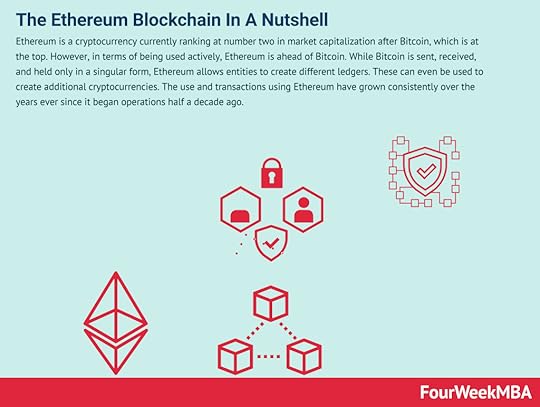 Ethereum is a cryptocurrency currently ranking at number two in market capitalization after Bitcoin, which is at the top. However, in terms of being used actively, Ethereum is ahead of Bitcoin. While Bitcoin is sent, received, and held only in a singular form, Ethereum allows entities to create different ledgers. These can even be used to create additional cryptocurrencies. The use and transactions using Ethereum have grown consistently over the years ever since it began operations half a decade ago.
Ethereum is a cryptocurrency currently ranking at number two in market capitalization after Bitcoin, which is at the top. However, in terms of being used actively, Ethereum is ahead of Bitcoin. While Bitcoin is sent, received, and held only in a singular form, Ethereum allows entities to create different ledgers. These can even be used to create additional cryptocurrencies. The use and transactions using Ethereum have grown consistently over the years ever since it began operations half a decade ago. 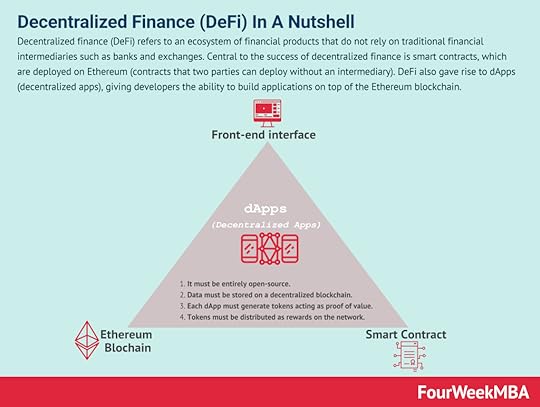 Decentralized finance (DeFi) refers to an ecosystem of financial products that do not rely on traditional financial intermediaries such as banks and exchanges. Central to the success of decentralized finance is smart contracts, which are deployed on Ethereum (contracts that two parties can deploy without an intermediary). DeFi also gave rise to dApps (decentralized apps), giving developers the ability to build applications on top of the Ethereum blockchain.
Decentralized finance (DeFi) refers to an ecosystem of financial products that do not rely on traditional financial intermediaries such as banks and exchanges. Central to the success of decentralized finance is smart contracts, which are deployed on Ethereum (contracts that two parties can deploy without an intermediary). DeFi also gave rise to dApps (decentralized apps), giving developers the ability to build applications on top of the Ethereum blockchain. Smart contracts are protocols designed to facilitate, verify, or enforce digital contracts without the need for a credible third party. These contracts work on an “if/when-then” principle and have some similarities to modern escrow services but without a third party involved in guaranteeing the transaction. Instead, it uses blockchain technology to verify the information and increase trust between the transaction participants.
Smart contracts are protocols designed to facilitate, verify, or enforce digital contracts without the need for a credible third party. These contracts work on an “if/when-then” principle and have some similarities to modern escrow services but without a third party involved in guaranteeing the transaction. Instead, it uses blockchain technology to verify the information and increase trust between the transaction participants. Non-fungible tokens (NFTs) are cryptographic tokens that represent something unique. Non-fungible assets are those that are not mutually interchangeable. Non-fungible tokens contain identifying information that makes them unique. Unlike Bitcoin – which has a supply of 21 million identical coins – they cannot be exchanged like for like. What commercial applications did distributed ledgers find so far?
Non-fungible tokens (NFTs) are cryptographic tokens that represent something unique. Non-fungible assets are those that are not mutually interchangeable. Non-fungible tokens contain identifying information that makes them unique. Unlike Bitcoin – which has a supply of 21 million identical coins – they cannot be exchanged like for like. What commercial applications did distributed ledgers find so far?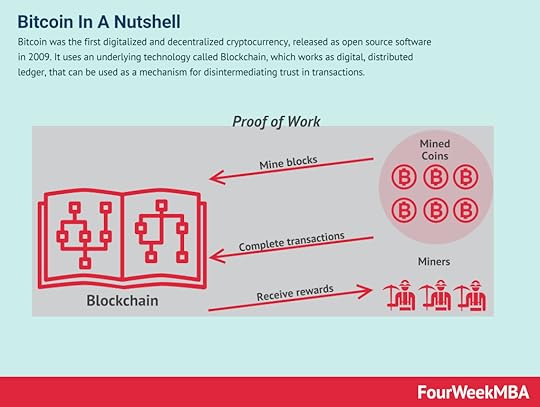 Bitcoin was the first digitalized and decentralized cryptocurrency, released as open-source software in 2009. It uses an underlying technology called Blockchain, which works as digital, distributed ledger, that can be used as a mechanism for disintermediating trust in transactions.
Bitcoin was the first digitalized and decentralized cryptocurrency, released as open-source software in 2009. It uses an underlying technology called Blockchain, which works as digital, distributed ledger, that can be used as a mechanism for disintermediating trust in transactions. Distributed Ledger is the underlying technology for Bitcoin, one of the first distributed ledger systems with a wide commercial application.
The biggest benefit of DLT is the fact that the information recorded can be updated by multiple parties independently without any administration on their part.
The process is a peer to peer, allowing transactions to be sent to multiple participants and updating each transaction at the same time. The distributed ledger technology in itself has the ability to track money transfers, manage the transfer of assets, and monitor access to payment services.
As the adoption of DLT increases, it has the potential to transform the way transactions are recorded.
Read Next: Blockchain Economics, Bitcoin, Ethereum, DeFI, NFT.
Main Free Guides:
Business ModelsBusiness StrategyBusiness DevelopmentDigital Business ModelsDistribution ChannelsMarketing StrategyPlatform Business ModelsRevenue ModelsTech Business ModelsThe post What Is A Distributed Ledger And Why It Matters In Business? appeared first on FourWeekMBA.
U vs M-form Organizational Structure
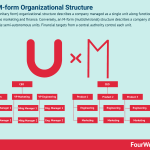
A U-form (unitary form) organizational structure describes a company managed as a single unit along functional lines such as marketing and finance. Conversely, an M-form (multidivisional) structure describes a company divided into multiple semi-autonomous units. Financial targets from a central authority control each unit.
Understanding the U-form organizational structure.The U-form organization relies on a functional approach to departmentalization and is often used to implement a single-product strategy. Developed during the railroad boom of the mid-19th century, the U-form structure was a great feat of organizational achievement. It helped rapidly growing companies manage their operations as scale and complexity increased. This gave rise to the first salaried managers with technical expertise and specialization.
This now conventional structure features a central management unit with several functionally organized departments. Decision-making is somewhat decentralized. Together with higher line authority, managers have the authority to delegate functional tasks to subordinates.
Since the U-form organizational structure emphasizes functional activities, coordination between each is crucial.
AdvantagesProductivity. Functional specialization increases productivity through effective division of labor. For example, marketing specialists improve the performance of the marketing function and allow the company to expand through increasing managerial capacity. In turn, this reduces the workload of the CEO who is free to concentrate on more critical issues.Cost savings. Compared to other configurations, the costs of staffing each department in a U-form structure are significantly lower. The U-form structure facilitates a wide span of management, where single managers or supervisors oversee a large number of subordinates. This also helps the firm centralize authority.DisadvantagesControl loss. As the company grows larger, there is a progressive reduction in the ability of management to control it. As information is passed down through various levels of management, it can be subject to deliberate or accidental distortion.Narrow focus. Since each senior manager is concerned with the efficient operation of their own functional area, they tend to devote less thought to wider company strategy. Worse still, senior managers may behave in such a way as to further their interests at the expense of others.Understanding the M-form organizational structureThe M-form organizational structure became popular in the United States during the 1960s.
In the preceding decade, the post-war consumer boom saw the creation of new global mass markets for consumer goods. As a result, most organizations wanted to cash-in on this rapid growth by expanding into new markets and diversifying their product range.
This could only be achieved by utilizing the decentralized multidivisional business model seen in the M-form structure. Here, each business has a central office. But unlike the U-form structure, each functional division is allowed to make its own operational decisions.
History will show that the M-form structure allowed companies to manage a diverse range of products while maintaining efficiency and maximizing profit. The structure also enabled businesses to implement a corporate strategy of related diversification.
Pioneered by General Motors and DuPont, the multidivisional form is now the most widely used among large modern firms.
AdvantagesAn optimal level of centralization. Larger firms that enjoy distinct branding and economies of scale can also enjoy the operational flexibility of a much smaller firm. While a central authority still dictates general organizational direction, each division operates as its own entity. In other words, it is responsible for making a profit and catering to its own needs. This means it – and by extension, the company – can still operate if another division fails.Incentivization and accountability. If a specific division is underperforming then it is easy to hold a manager accountable. Increased accountability encourages management to perform, particularly when such performance is actively and transparently measured against competing divisions.DisadvantagesCost of management. With a greater number of managerial staff comes increased wage expenditure. This problem is exacerbated when one considers that the M-form structure favors specialization and expertise. While these qualities can drive growth, they also demand regular pay raises, bonuses, and other incentives.Function duplication. The duplication of functions can also increase operating costs by diluting the benefits of economies of scale. In some cases, the duplication of functions leads to a lack of standardization when one division undercuts another to receive performance incentives.Key takeaways:A U-form (unitary form) organizational structure is used to implement a single-product strategy. Companies using this approach are managed as a single unit along functional lines such as finance and marketing.An M-form (multidivisional form) organizational structure describes a company divided into multiple functional divisions. Each division has some degree of autonomy from a central authority.During the post-war consumer boom, the M-form began to replace the U-form as the organizational structure of choice. This occurred as the M-form structure gave businesses the ability to expand into new markets with a diversified product range and maximize profits.Read Next: Organizational Structure.
Main Free Guides:
Business ModelsBusiness StrategyBusiness DevelopmentDigital Business ModelsDistribution ChannelsMarketing StrategyPlatform Business ModelsRevenue ModelsTech Business ModelsThe post U vs M-form Organizational Structure appeared first on FourWeekMBA.
Microsoft Organizational Structure In A Nutshell
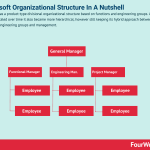
Microsoft has a product-type divisional organizational structure based on functions and engineering groups. As the company scaled over time it also became more hierarchical, however still keeping its hybrid approach between functions, engineering groups, and management.
Understanding Microsoft’s organizational structureMicrosoft has a product-type divisional organizational structure, with each division focusing on a specific line of goods and services. Furthermore, each has a separate research and development arm and dedicated sales and customer support staff.
Since current CEO Satya Nadella was appointed in 2015, the company has undergone several structural changes. Presently, Microsoft has two core engineering (product development) divisions:
Cloud and Artificial Intelligence Platforms.Experiences and Devices.Functional structureMicrosoft has a further seven functional divisions:
Business Development and Evangelism.Finance.Human Resources.Legal and Corporate Affairs.Engineering (operating systems, devices, studios, applications, services, and cloud and enterprise units).Dynamics.Advanced Strategy and Research.Despite each division having some autonomy, divisional heads must still report directly to Nadella.
Geographic divisionsMicrosoft also contains two geographic divisions: United States and International.
Other characteristics of Microsoft organizational structureSpan of controlMicrosoft has a wide span of control (SOC). This means the company has a comparatively higher number of subordinates under a single manager.
CentralizationUnlike Apple – where decision-making is made by all levels of management – Microsoft remains predominantly centralized with decisions made by those with authority.
Instituted by Bill Gates, centralized decision-making standardizes work output and removes the potential for personal biases. This creates a unified company with universal standards of performance and progression.
Advantages and disadvantages of Microsoft’s corporate structureAdvantagesStreamlined innovation. With a product-based divisional structure, employees work on projects that suit their skills and expertise. Supportive leadership with access to the CEO gives product specialists the freedom and resources to innovate. This ties in nicely with Microsoft’s core strategy of creating a family of integrated devices and services.Minimization of internal conflict. With little overlap in the scope of each division’s activities, there is little chance for conflict over resources or skills. Flexibility and responsiveness. Each division operates as a pseudo-entity, equipped with the functions and resources necessary to accomplish its mission. As a whole, this makes the divisional structure of Microsoft more adaptative. Divisions can be added, removed, or merged as required and do not impact other units.DisadvantagesIncompatibility. The divisional structure has led to a scenario where Microsoft’s own products were incompatible with each other. This occurred when the business software division was unable to integrate Microsoft SharePoint with Windows Live.Minimal consideration for international markets. Microsoft has a sole geographic division for the rest of the world sans the United States. It could be argued that a single geographic division fails to capture the nuanced differences of regional markets.Key takeaways:Microsoft has a product-based divisional organizational structure. The company has sought to streamline product development over the years, with current CEO Satya Nadella creating just two product divisions. These are Cloud and Artificial Intelligence Platforms and Experiences and Devices.Microsoft has a further seven functional divisions, with each divisional head reporting directly to Nadella.Microsoft’s divisional structure helps it streamline innovation and support a core strategy of integrated products and services. Divisions also help the company operate as a collection of flexible and adaptive entities with separate missions and access to resources.Read Next: Organizational Structure, Microsoft Business Model, Microsoft SWOT, Microsoft Mission.
Main Free Guides:
Business ModelsBusiness StrategyBusiness DevelopmentDigital Business ModelsDistribution ChannelsMarketing StrategyPlatform Business ModelsRevenue ModelsTech Business ModelsThe post Microsoft Organizational Structure In A Nutshell appeared first on FourWeekMBA.
Nike Organizational Structure In A Nutshell
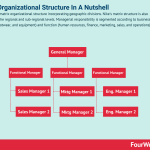
Nike has a matrix organizational structure incorporating geographic divisions. Nike’s matrix structure is also present at the regional and sub-regional levels. Managerial responsibility is segmented according to business unit (apparel, footwear, and equipment) and function (human resources, finance, marketing, sales, and operations).
Understanding the Nike organizational structureNike is the world’s most valuable global apparel brand, estimated to be worth dozens of billions.
The company has a matrix organizational structure that combines aspects of a hierarchical and product-based structure.
To support the immense valuation of the Nike brand, teams are divided based on product and must report to project managers. These teams are also accountable to broader department managers who handle policy and regulation. The presence of multiple chains of command with overlapping responsibility is a key feature of the matrix approach.
There are four main components to Nike’s organizational structure. In the following sections, we will look at each of these in more detail.
Global corporate leadershipAt the top of the hierarchy is global corporate leadership. This comprises managers who make corporate decisions that have global ramifications for the company. For example, the responsibility for creating a worldwide marketing campaign ultimately rests with a single group at company headquarters.
Each group is headed by a President, Executive Vice President, or Chief Officer:
Nike brand.Finance.Global human resources.Administration and legal.Office of the President and CEO of Nike Inc.Global sports marketing.Operations.Product and merchandising.Each is also based at the global headquarters in Beaverton, Oregon, and is responsible for managing operations in the United States, Americas, and Asia Pacific.
Nike executives note that this structure allows employees to identify with a streamlined company culture that makes consumer needs a priority. They also note that it enables the company to develop a valuable, globalized, and instantly recognizable brand regardless of geographic location.
Regional headquartersIn the case of the EMEA (Europe, Middle East, and Africa) region, operations for 27 countries are managed by a centralized European headquarters in the Netherlands.
EMEA is further segregated into sub-regions including France, Iberia, Italy, Northern Europe, UK & Ireland, AGSS (Austria, Germany, Slovenia, Switzerland), and CEMEA (Central Europe, Middle East, Africa).
Here, the additional level of hierarchy seeks to reduce complexity by managing the number of direct reports for each senior manager. By grouping single markets into regions, fewer direct reports need to be funneled back to regional headquarters.
Sub-regions are semi-autonomous geographic divisions, allowing Nike to build synergies derived from the grouping of countries. For example, AGSS was created to streamline logistics, finance, and marketing operations for each member of the group.
Further streamlining is also seen by examining the way the countries themselves are grouped. They may be clustered according to:
Consumer similarities. For example, consumers in the UK and Ireland are likely to have similar preferences and expectations. This helps Nike adjust marketing strategies accordingly.Retail similarities, or a likeness of retail structures.Similarities in market size or market development stage.Regional matrix structure and subsidiariesRegional matrix structureNike’s matrix structure is also present at the regional and sub-regional levels. Managerial responsibility is segmented according to:
Business unit – apparel, footwear, and equipment.Function – human resources, finance, marketing, sales, and operations.Again, the employee must report to two managers. In this case, the functional department manager and the product manager.
SubsidiariesNike has 54 wholly-owned subsidiaries, including Umbro, Cole Haan, Converse, and Hurley.
Like sub-regions, these subsidiaries enjoy some level of autonomy. However, projects exceeding limits set by either the regional or global headquarters must obtain approval.
Generally speaking, subsidiaries are free to make operational decisions at the country level. These decisions may encompass the implementation of plans, local initiatives, or adaptation strategies.
Key takeaways:Nike has a matrix organizational structure with a strong preference for geographic and regional divisions.At the top of the Nike hierarchy is global corporate leadership headquartered in Beaverton, Oregon. Senior executives head seven functional groups that manage operations in the United States, Americas, and Asia Pacific.Nike also has regional headquarters in the Netherlands that manages Europe, Middle East, and Africa. Countries in these regions are segregated to streamline operations and group consumers with similar preferences or attributes.Read Next: Organizational Structure, Nike Business Model, Nike Mission, Nike SWOT, Nike Pestel.
Main Free Guides:
Business ModelsBusiness StrategyBusiness DevelopmentDigital Business ModelsDistribution ChannelsMarketing StrategyPlatform Business ModelsRevenue ModelsTech Business ModelsThe post Nike Organizational Structure In A Nutshell appeared first on FourWeekMBA.
Amazon Organizational Structure In A Nutshell
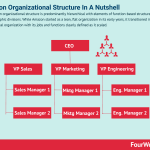
The Amazon organizational structure is predominantly hierarchical with elements of function-based structure and geographic divisions. While Amazon started as a lean, flat organization in its early years, it transitioned into a hierarchical organization with its jobs and functions clearly defined as it scaled.
Understanding the Amazon organizational structureAmazon is the largest eCommerce company in the world, employing over a million people spread across many different countries.
The Amazon organizational structure favors a vertical hierarchical approach with global, function-based groups and geographic divisions. This gives the company extensive top-down control over global operations, allowing it to increase market share and maintain market leadership status.
At the top of this chain is a senior management team reporting directly to CEO Jeff Bezos. Dubbed the S Team, this small team of Amazon senior executives works with Bezos to disseminate his ideas, solve problems, set high-level goals, and shape company culture.
The S Team has senior executives in charge of several function-based groups, including:
Finance.Human resources.Corporate affairs.Amazon Web Services (AWS).Worldwide consumers.Amazon devices and digital management.Worldwide operations.Legal and secretariat.Geographic divisionsDespite the vast geographical reach of Amazon, the company only has two geographic divisions: North America and International.
The company also utilizes groups according to physical location and related business goals. For instance, Amazon.com Inc. is the eCommerce arm of the company. It uses groups to manage eCommerce operations according to geographic regions and their associated regulatory frameworks and logistical challenges. Ultimately, this allows Amazon to address country or region-specific issues proactively and efficiently.
How has Amazon used organizational structure to its advantage?Many would assume that a large, hierarchical organization would be rigid and resistant to change.
However, this is not the case at Amazon. The company is a flexible and adaptive market leader in eCommerce. Indeed, Amazon has caused disruptive innovation in online marketplaces and also in global logistics.
How is this status maintained in the face of centralized decision-making and top-down control?
One key contributing factor is the Two Pizza Rule. Instituted by Bezos, the Two Pizza Rule states that no meeting should be so large that two pizzas cannot feed the entire group.
The goal here is efficiency and scalability. Smaller teams spend less time managing timetables or keeping others in the loop and more time doing what needs to be done. In turn, each team has access to company resources to meet short and long-term goals. A product team, for example, can add new product lines without having to meet with the project, process, or logistics teams.
In purely theoretical terms, these teams are given more autonomy than say a worker in an Amazon warehouse. But they are very much marching to the beat of Bezos’ drum.
StabilityStability is also a notable feature of the Amazon organizational structure – particularly in senior management.
Although there are frequent new additions to the S Team, many members have been in the same position for years or in some cases, decades. The long-term success of the hierarchical model has resulted in a highly experienced senior management team.
Ultimately, this has allowed Amazon to grow and expand into new markets without sacrificing competitiveness.
Key takeaways:Amazon is a predominantly hierarchical organization incorporating function-based groups and geographic divisions.Reportable to CEO Jeff Bezos is a group of senior executives called the S Team. Each member of the S Team is responsible for leading a functional or business unit. Many of these units are in fact large organizations in themselves.Amazon has maintained its position as a flexible and adaptable market leader despite a rigid hierarchical structure. To some extent, this has been facilitated by small product teams having autonomous access to company resources and stable, experienced leadership.Read Next: Organizational Structure, Amazon Business Model, Amazon Mission.
Main Free Guides:
Business ModelsBusiness StrategyBusiness DevelopmentDigital Business ModelsDistribution ChannelsMarketing StrategyPlatform Business ModelsRevenue ModelsTech Business ModelsThe post Amazon Organizational Structure In A Nutshell appeared first on FourWeekMBA.
Flat Organizational Structure In A Nutshell
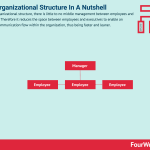
In a flat organizational structure, there is little to no middle management between employees and executives. Therefore it reduces the space between employees and executives to enable an effective communication flow within the organization, thus being faster and leaner.
Understanding a flat organizational structureA flat organizational structure has significantly fewer management layers than a traditional, hierarchical structure.
The structure is characterized by large teams reporting to a single manager. This scenario reduces the capacity for control over task execution and subsequent micromanagement.
In some businesses, there is a complete absence of middle management with frontline employees reporting directly to executives. This creates a collaborative and interconnected work environment well suited to start-ups or any organization wishing to adopt a more modern management approach.
Gaming company Valve is perhaps the most extreme example of a flat organizational structure. Valve employees do not hold titles and they are not issued with directives by middle or upper management.
Instead, the company has adopted a visible, collaborative approach. Every employee can see what projects are being worked on and join the team of any project that takes their fancy. Valve employees can also start their own projects provided they can secure funding and build a competent team.
Strengths and weaknesses of a flat organizational structureCompanies such as Valve are the exception rather than the rule.
With that in mind, let’s take a look at the strengths and weaknesses of the flat structure to get an idea of where it may be best suited.
StrengthsLower operating costs. When employees are given more freedom to make decisions, there is little need for mid-level management. This saves the business a significant amount of money on wages that can be directed elsewhere.Improved communication. In a hierarchical structure, information moves slowly up the chain as it works its way through various levels of management. In a flatter structure, communication does not need to go through several intermediaries and becomes more efficient as a result. The quality of communication also increases because there is less potential for facts to be distorted or misinterpreted.Increased employee motivation and satisfaction. Autonomous employees tend to be more motivated to produce desirable results for the company. This increases morale and productivity while also decreasing employee turnover.WeaknessesUnsuitable for large organizations. The flat structure is most suited to start-ups and smaller businesses with a manageable number of employees. In larger organizations, the ratio of employees to managers can become disproportionate. Management may be unaware of unmotivated or poorly behaving employees. They may also lack the required support to effect important decisions.Hinders employee retention. While some employees will be content to work under a flat structure indefinitely, others will want to climb the corporate ladder. Given that there is little scope for promotion, aspiring employees may seek work elsewhere.Creates power struggles. When employees do not have the overarching presence of a superior, power struggles can develop. This creates confusion and disharmony and also causes a loss of productivity.Key takeaways:A flat organizational structure describes any business with a lack of middle management between employees and executives.A flat organizational structure is perhaps best exemplified in gaming company Valve. Title-less employees are given the autonomy to work on any project of their choosing. Provided they can secure the funding and manpower, they can also start their own projects.A flat organizational structure lowers wage costs significantly, allowing many start-ups and smaller companies to remain viable. Larger businesses will find the flat structure unsuitable as the ratio of employees to managers becomes untenable.Read Next: Organizational Structure.
Main Free Guides:
Business ModelsBusiness StrategyBusiness DevelopmentDigital Business ModelsDistribution ChannelsMarketing StrategyPlatform Business ModelsRevenue ModelsTech Business ModelsThe post Flat Organizational Structure In A Nutshell appeared first on FourWeekMBA.
March 29, 2021
Matrix Organizational Structure In A Nutshell
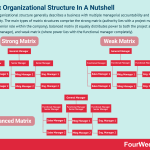
A matrix organizational structure generally describes a business with multiple managerial accountability and responsibility. The main types of matrix structures comprise the strong matrix (authority lies with a project manager who has a senior role within the company), balanced matrix (it equally distributes power to both the project and functional manager), and weak matrix (where power lies with the functional manager completely).
Understanding a matrix organizational structureThere are no set guidelines for a matrix organizational structure. This is because the matrix structure is simply a combination of two or more structure types to give each more balance. As a result, a business can create a matrix structure according to its particular needs and the industry it operates in.
Nevertheless, most organizations using this structure incorporates two chains of command. One manages functional activities while the other is tasked with managing projects, products, or clients. It’s important to note that these roles are fluid and the balance of power between each manager is not organizationally defined.
Rather than one project manager overseeing every aspect of a project, employees report to two or more managers. This arrangement is often useful when skills need to be shared across departments to complete a task.
Three types of matrix structuresThe matrix organizational structure can be divided into three types:
Strong matrix – where authority lies with a project manager who has a senior role within the company. With control over resources and distribution of tasks, the project manager may have more power than the functional manager.Balanced matrix – as the name suggests, the balanced matrix equally distributes power to both the project and functional manager. Employees report to the project manager who in turn reports to the functional manager to ensure accountability.Weak matrix – where power lies with the functional manager completely. In this scenario, the project manager has a role better defined as a project coordinator or expeditor. They act as a facilitator between the customer and the project team and can only institute minor project management directives.Advantages and disadvantages of the matrix organizational structureAdvantagesEnhanced communication – with none of the communication barriers seen in a purely hierarchical structure, communication between departments is fluid and collaborative. Large and diverse companies featuring many functional units can collectively work toward a shared goal.Employment development – employees working under a matrix structure are exposed to new methods and ways of thinking. This helps them push the boundaries of their comfort zones to further personal and organizational objectives.DisadvantagesLack of effectiveness. Large companies may suffer from organizational bloating, where a surplus of managerial and administrative roles combined with more points of communication may decrease productivity. The decision to combine various organizational structures may instead dilute the benefits each structure brings in isolation.Disharmony. Cross-functional working under a matrix structure does not always succeed. Teams can lose their best talent to other teams or departments indefinitely, causing further productivity losses and a decrease in morale. In some cases, employees returning to their teams after an unsuccessful stint elsewhere may have trouble re-integrating.Key takeawaysA matrix organizational structure describes any business with multiple chains of command. In general, the matrix structure is any that combines two or more organizational structure types.A matrix organizational structure can be divided into three types according to the way power is distributed to the project and functional manager. These encompass a hard matrix, balanced matrix, and weak matrix.The matrix structure enhances communication throughout the organization and encourages employee professional development. However, the amalgamation of several structure types in a large company may erode the particular benefits of each.Read Next: Organizational Structure.
Main Free Guides:
Business ModelsBusiness StrategyBusiness DevelopmentDigital Business ModelsDistribution ChannelsMarketing StrategyPlatform Business ModelsRevenue ModelsTech Business ModelsThe post Matrix Organizational Structure In A Nutshell appeared first on FourWeekMBA.



